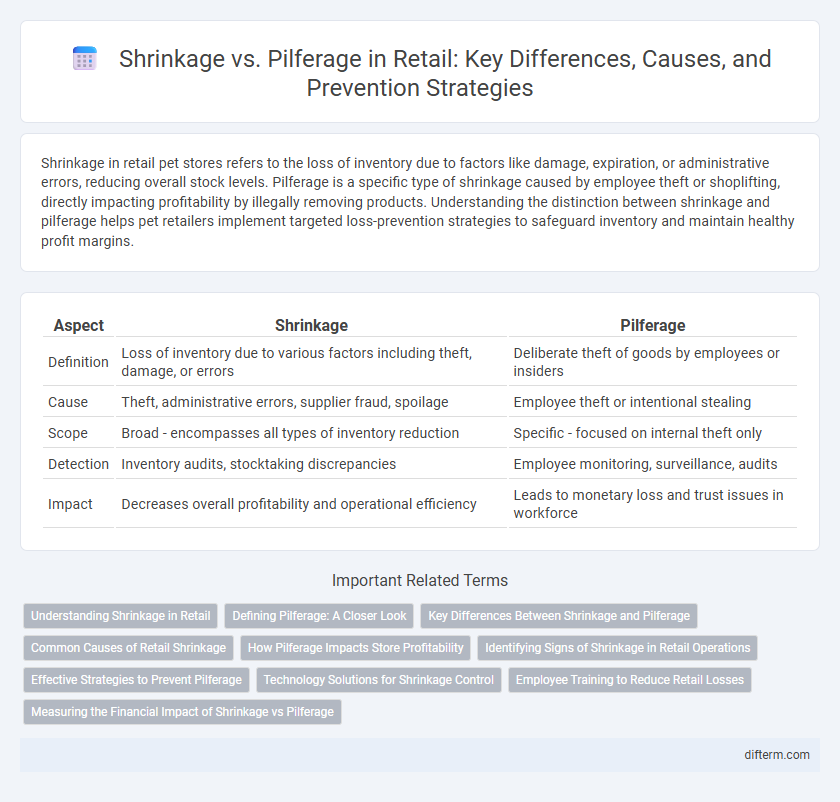Shrinkage in retail pet stores refers to the loss of inventory due to factors like damage, expiration, or administrative errors, reducing overall stock levels. Pilferage is a specific type of shrinkage caused by employee theft or shoplifting, directly impacting profitability by illegally removing products. Understanding the distinction between shrinkage and pilferage helps pet retailers implement targeted loss-prevention strategies to safeguard inventory and maintain healthy profit margins.
Table of Comparison
| Aspect | Shrinkage | Pilferage |
|---|---|---|
| Definition | Loss of inventory due to various factors including theft, damage, or errors | Deliberate theft of goods by employees or insiders |
| Cause | Theft, administrative errors, supplier fraud, spoilage | Employee theft or intentional stealing |
| Scope | Broad - encompasses all types of inventory reduction | Specific - focused on internal theft only |
| Detection | Inventory audits, stocktaking discrepancies | Employee monitoring, surveillance, audits |
| Impact | Decreases overall profitability and operational efficiency | Leads to monetary loss and trust issues in workforce |
Understanding Shrinkage in Retail
Retail shrinkage refers to the loss of inventory due to factors such as theft, administrative errors, and damage, often impacting profit margins significantly. Pilferage, a subset of shrinkage, specifically involves employee or customer theft, accounting for a large percentage of inventory loss in retail environments. Effective shrinkage management requires comprehensive loss prevention strategies combining technology, employee training, and inventory control systems.
Defining Pilferage: A Closer Look
Pilferage in retail refers to the act of employees stealing merchandise or cash, significantly impacting overall shrinkage rates. Unlike general shrinkage, which includes losses from errors, fraud, or supplier issues, pilferage specifically involves internal theft. Understanding pilferage helps retailers implement targeted security measures and employee monitoring to reduce inventory losses.
Key Differences Between Shrinkage and Pilferage
Shrinkage in retail refers to the overall loss of inventory due to factors like theft, administrative errors, and damage, while pilferage specifically denotes theft of small quantities by employees or customers. Shrinkage encompasses a broader range of causes, including vendor fraud and paperwork mistakes, whereas pilferage is a focused subset related solely to deliberate stealing. Understanding these distinctions helps retailers implement precise loss prevention strategies and improve inventory accuracy.
Common Causes of Retail Shrinkage
Retail shrinkage primarily results from pilferage, which includes employee theft, shoplifting, and organized retail crime. Other common causes include administrative errors like inaccurate inventory management, supplier fraud, and damaged or expired goods. Understanding these factors helps retailers implement targeted loss prevention strategies to protect their profit margins.
How Pilferage Impacts Store Profitability
Pilferage, a form of shrinkage involving employee theft, directly reduces store profitability by increasing inventory loss and operating costs. It leads to inaccurate stock levels, resulting in overstocking or stockouts, which disrupts sales and customer satisfaction. Effective pilferage prevention strategies are essential to safeguard profit margins and maintain accurate financial reporting.
Identifying Signs of Shrinkage in Retail Operations
Shrinkage in retail operations encompasses losses from inventory discrepancies due to theft, administrative errors, or supplier fraud, with pilferage being a specific form involving employee theft of merchandise. Key signs of shrinkage include frequent inventory variances, unexplained stock shortages, irregularities in transaction records, and an increase in customer complaints regarding missing or damaged products. Monitoring security footage, conducting regular inventory audits, and analyzing point-of-sale data are essential strategies for identifying potential shrinkage and mitigating its impact on retail profitability.
Effective Strategies to Prevent Pilferage
Pilferage, a major contributor to retail shrinkage, involves the intentional theft of products by employees or customers, requiring targeted prevention strategies. Implementing comprehensive employee training programs, utilizing advanced surveillance systems, and enforcing strict inventory control measures significantly reduce pilferage incidents. Retailers adopting these methods experience lower shrinkage rates, improved profitability, and enhanced store security.
Technology Solutions for Shrinkage Control
Advanced technology solutions such as RFID tracking, video analytics, and AI-powered inventory management systems significantly reduce retail shrinkage by providing real-time visibility and predictive loss detection. These tools help differentiate shrinkage causes, enabling targeted interventions against pilferage by employees or shoplifters. Integrating IoT sensors and automated alerts enhances accuracy in inventory audits, minimizing both internal and external theft efficiently.
Employee Training to Reduce Retail Losses
Effective employee training significantly reduces retail shrinkage by educating staff on loss prevention techniques and recognizing suspicious behaviors. Emphasizing awareness of pilferage, the intentional theft by employees, training programs foster a culture of accountability and vigilance. Retailers that invest in comprehensive training see measurable declines in inventory losses and improved overall store security.
Measuring the Financial Impact of Shrinkage vs Pilferage
Measuring the financial impact of shrinkage versus pilferage requires analyzing inventory discrepancies and associating losses directly with theft, errors, or damage. Retailers often track shrinkage by comparing recorded inventory levels against actual stock counts, while pilferage is isolated through incident tracking and loss prevention data. Accurate financial assessments leverage point-of-sale data, surveillance analytics, and inventory turnover rates to quantify the cost implications effectively.
Shrinkage vs Pilferage Infographic

 difterm.com
difterm.com